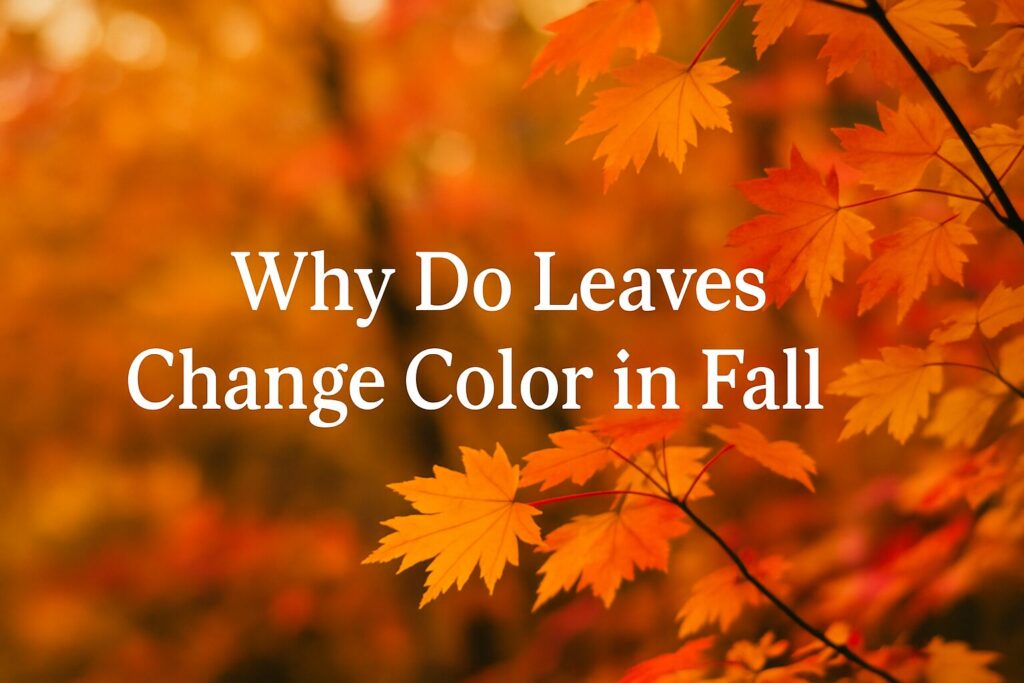
Wondering why do leaves change color in fall? The short answer is that as days get shorter and cooler, green chlorophyll fades, revealing other pigments—and in some trees, new red pigments form—so forests shift into oranges, yellows, and reds. In this guide, you’ll learn the science behind why do leaves change color in fall and what makes some years more vibrant than others.
Quick Answer (in 3 lines)
- Shorter days signal leaves to shut down food-making and stop producing chlorophyll (the green pigment).
- As chlorophyll breaks down, yellow/orange carotenoids and tannins become visible.
- Cool, sunny days and crisp nights can trigger red anthocyanins, making fall color pop.
The Role of Chlorophyll
All summer, chlorophyll dominates because trees are busy photosynthesizing. It continually breaks down and is replaced, keeping leaves green. As autumn approaches, trees form an abscission layer at the base of each leaf and begin reclaiming valuable nutrients. Production of chlorophyll slows and then stops. This is the first key to why do leaves change color in fall: remove the strong green signal, and the hidden palette underneath appears.
Hidden Colors: Carotenoids and Tannins
Carotenoids (yellows and oranges) are present in leaves all season but are masked by chlorophyll. When the green fades, birches, aspens, and many maples display golds and ambers. Oaks and beeches often turn bronze or brown due to tannins. These pigments explain part of why do leaves change color in fall across species—different trees have different baseline pigment mixes.
Brilliant Reds: Anthocyanins
Reds and purples in many maples, dogwoods, and sumacs often come from anthocyanins, which are produced in autumn. Sunny days load leaves with sugars; cool (but not freezing) nights slow those sugars from exiting. That sugar buildup can stimulate anthocyanin production, intensifying reds. This is a big reason why do leaves change color in fall varies year to year—weather controls how much red shows up.
Weather: What Makes a “Good Color” Year?
- Sun + Cool Nights: Bright days promote sugar production; cool nights trap sugars in leaves, boosting reds.
- Moisture Balance: A wet growing season followed by a mild, dry early fall tends to yield vivid colors. Severe drought dulls displays.
- No Early Hard Frosts: Hard freezes can halt pigment production and cause leaves to brown and drop quickly.
Because weather conditions differ by region and year, the intensity and timing of color shifts—another facet of why do leaves change color in fall—can vary even between nearby parks.
Tree Species & Timing
Species differ in timing and pigment recipes. Aspens and birches lean yellow; sugar maples can blaze orange and red; red maples and sumacs push deeper crimson. Oaks often hold leaves late and turn russet. Microclimates add complexity: elevation, slope direction, wind exposure, and urban heat can all shift the calendar for why do leaves change color in fall locally.
What About Evergreens?
Conifers like pines and spruces keep needles all winter because their needle structure and waxy coatings reduce water loss and cold damage. They still lose some older needles each year, but gradually. That’s why evergreens don’t headline why do leaves change color in fall, even though subtle needle color changes occur.
At-Home Mini Demo (2 minutes)
- Collect a few green leaves of different species.
- Place each between white paper and gently rub with a spoon or roll a pen cap to make a “leaf print.”
- You’ll see varying golden or brownish tones appear alongside green—an easy visual hint of pigments involved in why do leaves change color in fall.
Care for Trees During Color Season
Autumn is a stress-balancing act for trees. Moderate watering during dry spells and avoiding heavy pruning late in the season can help. Healthy trees respond more predictably, so the visual story of why do leaves change color in fall is clearest in well-cared-for landscapes.
FAQ
Does cold weather alone make red leaves?
Cold helps, but it’s the combination of sunny days and cool nights that boosts red anthocyanins. Cloudy weeks or early hard frosts can mute color, which is why why do leaves change color in fall depends on the exact weather pattern.
Why do some years look dull?
Drought, heat waves, extended cloud cover, or early frost can cause leaves to brown or drop quickly. Those conditions interrupt pigment development, so why do leaves change color in fall may result in more golds/browns and fewer vivid reds.
Why do colors differ even on the same tree?
Sun exposure differs by branch. South-facing leaves may build more sugars and produce more red, while shaded areas stay yellow. That micro-variation is a small-scale example of why do leaves change color in fall even within a single crown.
Do all trees in a region peak at once?
No. Species mix, elevation, and local weather create overlapping peaks. That’s why local foliage reports track the rolling progression of why do leaves change color in fall across counties and parks.
Helpful Resources
- USDA Forest Service: The Science of Fall Colors
- Encyclopaedia Britannica: Autumn Colour
- NOAA: Weather & Fall Foliage
Explore More on AnswerNimbus
Curious about everyday science and nature? Browse more articles in our Facts & Explanations section. Understanding why do leaves change color in fall is just the beginning—there’s a whole world of clear, practical explanations to discover.
“`0AnswerNimbus is an online knowledge hub providing step-by-step guides, how-to fixes, and clear explanations across technology, home, collectibles, and everyday curiosities. Our mission is to make useful information easy to find, understand, and apply.
